7 Major Launches of the Maritime Industry in 2014
In 2014, the maritime industry saw the launching of some of the most interesting vessels ever made. It was an year of breaking old records and forming new ones. On one hand, the industry was fighting its own battle with serious issues of migrants, ebola and piracy whereas on other hand bigger and better ships were launched to meet the growing demands and to comply with the latest environment regulations.
Let’s take a look at some of the most important and noteworthy launches of the maritime industry in the year 2014.
1. World’s Largest Container Ship – CNCL Globe
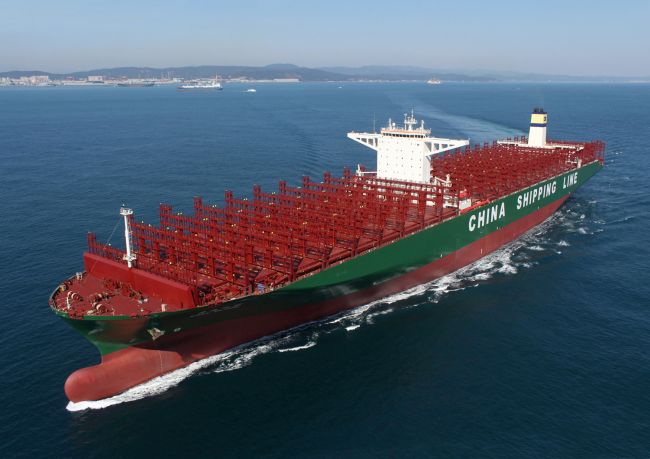
The world’s largest container ship- CSCL Globe with 19,100 TEU was launched in November 2014. Made by Hyundai Heavy Industries Co., Ltd. (HHI), the ship is as large as four soccer fields and measures 400.0 m in length, 58.6 m in width and 30.5 m in depth. The vessel has been deployed on the Asia-Europe trade loop and is one of the most energy efficient containers vessels in the world.
The CSCL Globe features a 77,200 bhp electronically controlled main engine that enhances fuel efficiency by automatically controlling fuel consumption to reflect the vessel’s current speed and the sea conditions. As a result, the containership will burn 20 per cent less fuel per TEU in comparison to a reference 10,000 TEU containership.
The vessel and its upcoming sister ships have also implemented the RSCS class notation (Route Specific Container Stowage). The RSCS notation was developed by DNV GL to provide an even more efficient usage of cargo capacity with more flexibility and more laden containers on board on specific routes without compromising on safety.
Reflecting the environmental performance of the CSCL Globe and her sister ships, the vessels will all hold the class notation EP-D (Environmental Passport Design), demonstrating their preparedness and compliance with environmental regulations. EP-D documents compliance with all relevant MARPOL regulations and other environment-related IMO conventions. The notation also shows that the vessel meets upcoming requirements, such as ballast water management, ship recycling, bilge water separation and recovery of refrigerants.
The new delivered CSCL GLOBE is the first one of the five 19100 TEU vessels that China Shipping ordered from Hyundai Shipyard.
2. World’s Largest Offshore Vessel – Pieter Schlep
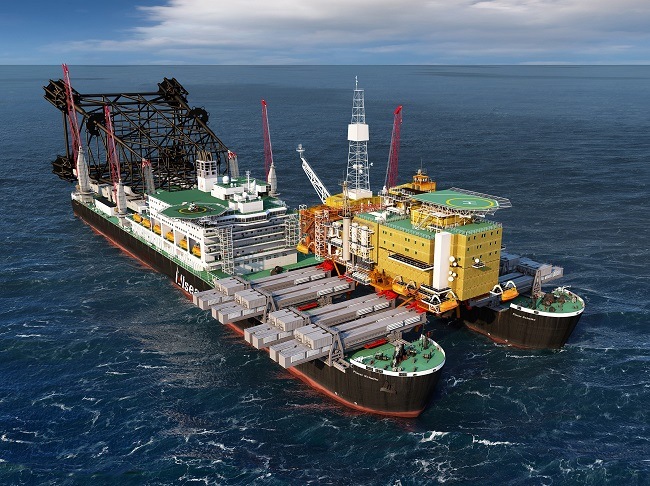
The sea trials for the world’s largest offshore vessel began in October 2014 near Daewoo Shipbuilding & Marine Engineering’s shipyard in Okpo, South Korea.
Pieter Schelte’ is 382 metres long and 124 metres wide. The length, in combination with the massive width, makes this vessel unique.
The unique vessel is intended for installing and removing topsides and jackets of large offshore oil and gas platforms in a single lift. At the bow of the vessel is a slot, where topsides are lifted. The vessel is also equipped for laying large pipelines and, with her capacity, will be the largest pipelay vessel as well. The vessel can lift topsides of offshore platforms weighing up to 48,000 tonnes and jackets up to 25,000 tonnes.
The vessel is equipped with eight diesel generators, providing a total installed power of 95 MW, driving 12 azimuth thrusters for dynamic positioning (DP3) and for propulsion. The maximum speed will be 14 knots. The accommodation has room for up to 571 persons in two-berth cabins.
3. Quantum of the Seas – The Third Largest and The Smartest Cruise Ship
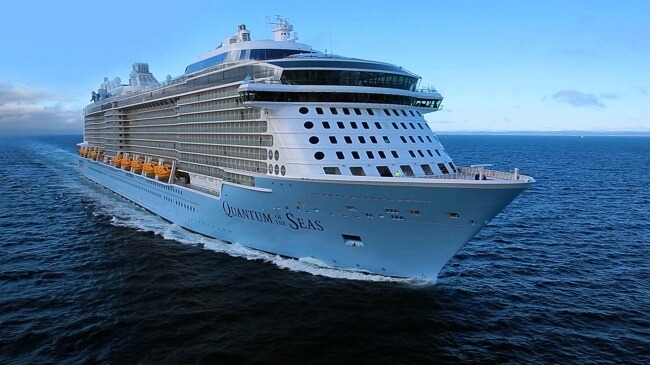
Quantum of the Seas, the third largest cruise ship in the world, is a Quantum class cruise ship from Royal Caribbean International which was launched this year. The Quantum-class ships surpass the earlier Freedom-class ships by over 14,000 GT, becoming the second largest class of passenger ships ships behind Royal Caribbean International’s Oasis class ships on a gross tonnage basis.
Termed as the smartest cruise ship in the world and the world’s first smartship, the Quantum of the Seas features some of the most advanced, never-seen-before technologies.
Quantum of the Seas is the first Quantum-class cruise ship and marks the next evolution in cruise ships for Royal Caribbean. It’s the first ship in the fleet to not be based on the Voyager-class lineage since the Voyager class debuted and is full of new technological innovations, entertainment advances and impressive decor.
Quantum of the Seas also marks the introduction to Royal Caribbean of Dynamic Dining, which is the company’s complete reboot of what dining is on a cruise ship. The main dining room as well as dress codes have been relaxed in an effort to simplify dinner for guests while expanding the choices passengers have.
4. World’s First Working FLNG – Caribbean FLNG
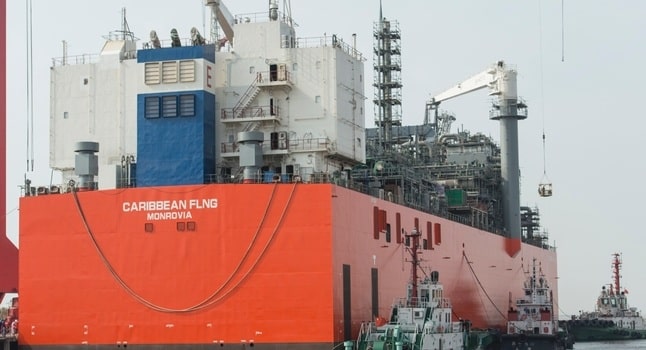
The World’s First Operational FLNG – Caribbean FLNG was undocked in November 2014. The Caribbean FLNG project, which is expected to be the world’s first operational FLNG facility, was delivered by Wison Offshore & Marine (Wison). The unit comprises a non-propelled barge that will be operated off the Caribbean coast of Colombia for Pacific Rubiales Energy and equipped to convert 72.0 million scf/d of natural gas into LNG (+/- 500,000 tons of LNG per annum) for temporary storage and export. Floating LNG liquefaction and storage (FLNG) facilities are expected to significantly reduce the cost and time required to monetise and deliver gas to market.
5. World’s Largest Jack up Rig – Maersk Interceptor
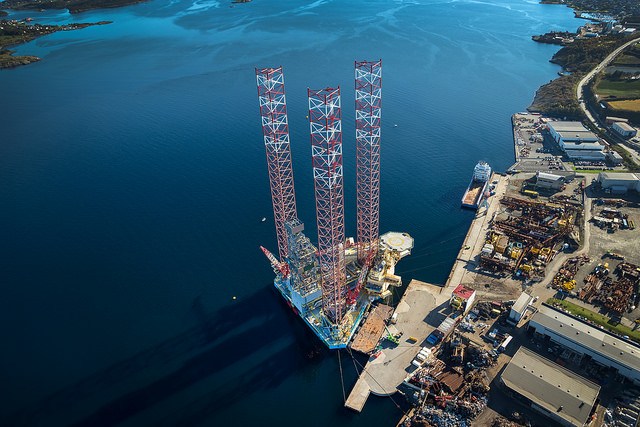
Maersk Interceptor, the world’s largest jack-up rig, was launched in October 2014.
Maersk Interceptor is the second in a series of four ultra harsh environment jack-up rigs to enter Maersk Drilling’s fleet. The four jack-up rigs represent a total investment of USD 2.6bn.
Maersk Interceptor will commence a five year firm contract with Det norske for drilling the Ivar Aasen field in the Norwegian North Sea in December 2014. The contract includes two one-year options. The estimated contract value for the firm contract is USD 700 million.
The first two jack-up rigs, the Maersk Intrepid and the Maersk Interceptor, have been delivered from the Keppel FELS shipyard. The third will be delivered from Keppel FELS in 2015, and the fourth will be delivered from the Daewoo Shipbuilding and Marine Engineering (DSME) shipyard in South Korea in 2016. All four have secured long term contracts with prime customers.
6. World’s Largest LNG Powered Platform Supply Vessel (PSV)
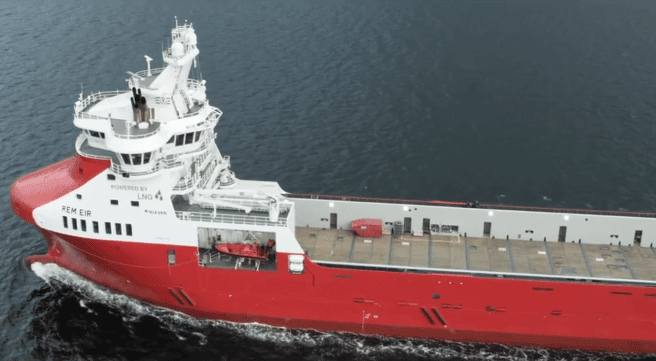
Rem Eir, the worlds largest LNG powered offshore supply vessel, built by Kleven Verft in Norway for Remøy Shipping and delivered in November 2014.
Designed by Wärtsila Ship Design and with a length of 92.5 metres and a deck capacity of 1080 m2, Rem Eir is the world’s largest environmentally friendly LNG powered PSV.
The vessel entered a long term chart for Statoil.
7. World’s First LNG Hybrid Barge
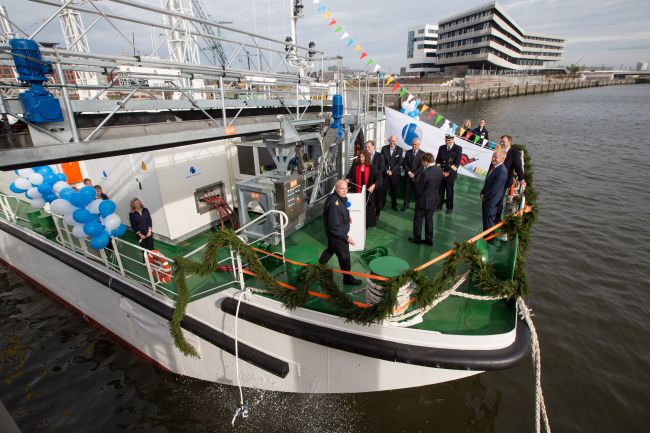
The world’s first LNG hybrid barge of Becker Marine Systems was christened in October in Hamburg. The floating LNG power plant will provide environmentally friendly energy supply to AIDA cruise ships.
With the use of the floating LNG power plant, emissions and particle discharge will be significantly reduced. Compared to the use of conventional marine diesel with 0.1 percent sulfur content, no sulfur oxides and no soot particles are emitted. Nitrogen oxide emissions will be reduced by up to 80 percent and carbon dioxide emissions by 30 percent.
Additional Mention:
Unique Tanker + Container + Dry Bulk Cargo Ship
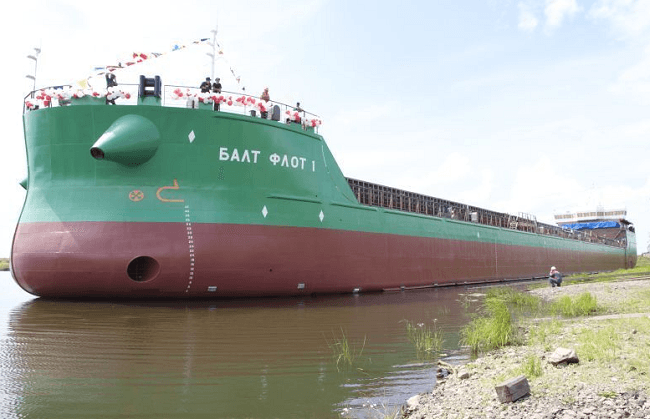
A unique “platform/tanker” vessel was launched in July, 2014. The one-of-a-kind vessel was created to be maximally effective during both legs of each round voyage (carrying oil when going to its destination and dry cargo on its return trip), thus planned to achieve the highest possible economic efficiency of the vessel’s operation given the seasonal nature to the river transport infrastructure in Russia.
The RST54 vessel is a self-propelled combined (oil/dry cargo) “Volgo-Don Max” class platform vessel with a deadweight of 5,589 tons intended for transporting up to 5,250 tons of light and dark oil products as well as general and bulk cargo, including gravel, metals, timber, coal, bulky and heavy cargoes. The motor vessel can carry up to 148 TEU’s worth of cargo in containers, up to 320 cars, up to 4,500 tons of bulk cargo.
The RST54 project is based on the idea of creating a genuinely general-duty cargo vessel capable of significantly improving the efficiency of operations in the restricted context of the available river infrastructure and the seasonal nature of the inland waterways navigation. Increasing the potential amount of cargo transported will make it possible to provide reasonable periods of investments return as well as raise funding for new vessels at attractive conditions.
Apart from the launching of above mentioned vessels, several important announcements were made on a series of major maritime projects which are either under construction or are about to enter production. Needless to say, the maritime industry is about to see some of the most fascinating and game-changing projects in the upcoming year 2015.
Disclaimer :
The information contained in this website is for general information purposes only. While we endeavour to keep the information up to date and correct, we make no representations or warranties of any kind, express or implied, about the completeness, accuracy, reliability, suitability or availability with respect to the website or the information, products, services, or related graphics contained on the website for any purpose. Any reliance you place on such information is therefore strictly at your own risk.
In no event will we be liable for any loss or damage including without limitation, indirect or consequential loss or damage, or any loss or damage whatsoever arising from loss of data or profits arising out of, or in connection with, the use of this website.

About Author
Raunek Kantharia is a marine engineer turned maritime writer and entrepreneur. After a brief stint at the sea, he founded Marine Insight in 2010. Apart from managing Marine Insight, he also writes for a number of maritime magazines and websites.
Do you have info to share with us ? Suggest a correction
Disclaimer :
The information contained in this website is for general information purposes only. While we endeavour to keep the information up to date and correct, we make no representations or warranties of any kind, express or implied, about the completeness, accuracy, reliability, suitability or availability with respect to the website or the information, products, services, or related graphics contained on the website for any purpose. Any reliance you place on such information is therefore strictly at your own risk.
In no event will we be liable for any loss or damage including without limitation, indirect or consequential loss or damage, or any loss or damage whatsoever arising from loss of data or profits arising out of, or in connection with, the use of this website.
Latest Marine Technology Articles You Would Like:
- 10 Harmful Effects Of Impure Air On Ship’s Machinery
- 10 Important Things to Check While Starting Fuel Oil Purifier on Ships
- 10 Noteworthy LNG-Powered Vessels
- 10 Points for Efficient Turbocharger Operation On Ships
- 10 Practical Tips to Handle Engine Room Pumps
- 10 Precautions to Take Before Operating Controllable Pitch Propeller (CPP) on Ships
Subscribe To Our Newsletters
By subscribing, you agree to our Privacy Policy and may receive occasional deal communications; you can unsubscribe anytime.
















owwsome pic n video..u all the best..